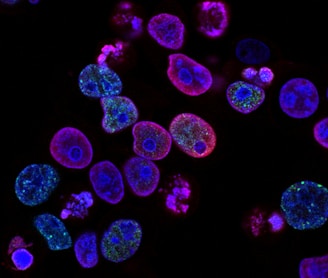Life on Earth can be traced back to a single ‘original’ species which originated 3.5 to 4 billion years ago in marine environments (Benton 2016).
4.1 to 3.1 billion years ago, archaea diverged from this common ancestor, with bacteria diverging between 3.2 and 2.5 billion years ago (UC Davis). It is estimated that eukarya split from archaea between 3,970 and 2,200 million years ago (Roger and Hug 2006).
The eukaryotic cell first arose with a prokaryotic cell’s loss of its protective cell wall, permitting the cell membrane to infold and in some regions enclose the cell’s DNA, thus forming the predecessor of a nucleus (Hillis et al 2019). With the development of a complex cytoskeleton, the evolution of lysomes, and finally – through endosymbiosis with proteobacteria and/or cyanobacteria – the cell mitochondria and/or chloroplasts, respectively, emerged (Hillis et al 2019).
It is possible that many species of unicellular eukaryotes diversified into multicellular organisms by associating with each other in colonies of vast numbers and presumably, at some point, integrating into multicellular organisms (Hillis et al 2019). This shift of the eukaryotes from single cells to multi-cells appears to have crystallized approximately 1.7 billion years ago (Cooper 2000).
500 to 350 million years ago, algae, plants, and animals moved onto land (Benton 2016). Terrestrial lifeforms then experienced not only speciation from marine organisms, but also across geographic barriers on land. Additionally, even within the same geographic region, speciation occurred – and continues to take place – by reason of different modes of adaptation to one’s environment and/or dependence on different food sources.
Prokaryotes are considered to be hugely successful compared to eukaryotes. Purely in terms of number of species, there are an estimated billion or more documented prokaryotic species globally, compared to 10-50 million species of eukaryotes (Cohan and Koeppel 2008).
The vast majority of prokaryotes live in seawater and soil (Whitman et al 1998). Prokaryotes capable of photosynthesis generate much of the net primary production in marine ecosystems, while non-photosynthetic prokaryotes help to break down organic compounds and return them to the food chain (Quéméneur et al 2020). In the soil, prokaryotes facilitate the decomposition of plant and animal matter into organic substances and nutrients (Whitman et al 1998).
One reason for prokaryotes’ resilience and enduring genetic diversity is their wide range of metabolic processes – they can obtain energy from sunlight, chemical compounds, and different carbon compounds (Georgia Tech). Further, because prokaryotes reproduce asexually, they do not require geographic isolation in order to speciate (Cohan and Koeppel 2008). Being unicellular, prokaryotes have larger surface-to-volume ratios relative to eukaryotes (especially multicellular eukaryotes) – this means prokaryote cells tend to exchange nutrients with the environment at a quicker rate, and therefore can breakdown and absorb nutrients and reproduce more rapidly (Sikorski 2015). Additionally, many prokaryotes are able to respire both aerobically and anaerobically (Duarte et al 2021). Thus prokaryotes have been observed to survive and thrive in extreme inhospitable environments.
(483 words)
References:
Benton, M.J. (2016). ‘Origins of Biodiversity’. PLOS Biology 14(11) 2016, pp.1–7.
Cohan, F.M., and Koeppel, A.F. (2008). ‘The Origins of Ecological Diversity in Prokaryotes’. Current Biology, Volume 18, Issue 21, 2008, Pages R1024-R1034, ISSN 0960-9822, https://doi.org/10.1016/j.cub.2008.09.014.
Cooper, G.M. (2000). ‘The Cell: A Molecular Approach. 2nd edition. Sunderland (MA): Sinauer Associates’. The Origin and Evolution of Cells. Available from: https://www.ncbi.nlm.nih.gov/books/NBK9841/
Duarte, A.G., Barbosa, A.C.C., Ferreira, Manteigas, D.G., Domingos, R.M., Pereira, I.A.C. (2021). ‘Redox loops in anaerobic respiration - The role of the widespread NrfD protein family and associated dimeric redox module’. Biochimica et Biophysica Acta (BBA) - Bioenergetics, Volume 1862, Issue 7, 2021, 148416, ISSN 0005-2728, https://doi.org/10.1016/j.bbabio.2021.148416.
Georgia Tech. ‘Prokaryotes: Bacteria & Archaea’. Georgia Tech Biological Sciences. Organismal Biology.
Hillis, D.M., C.H. Heller, S.D. Hacker, D.W. Hall, M.J. Laskowski, and D.E. Sadava. (2019). ‘Life: The science of biology’. (New York: W.H. Freeman, 2017). Chapter 25: Bacteria, archaea and viruses .
Quéméneur, M., Bel Hassen, M., Armougom, F., Khammeri, Y., Lajnef, R., and Bellaaj-Zouari, A. (2020) ‘Prokaryotic Diversity and Distribution Along Physical and Nutrient Gradients in the Tunisian Coastal Waters (South Mediterranean Sea)’. Front. Microbiol. 11:593540. doi: 10.3389/fmicb.2020.593540
Roger, A.J. and Hug, L.A. (2006). ‘The origin and diversification of eukaryotes: problems with molecular phylogenetics and molecular clock estimation’. Philos Trans R Soc Lond B Biol Sci. 2006 Jun 29;361(1470):1039-54. doi: 10.1098/rstb.2006.1845. PMID: 16754613; PMCID: PMC1578731.
Sikorski, J. (2015). ‘The Prokaryotic Biology of Soil’. Soil Organisms 87(1) April 2015, pp 1-28. http://www.soil-organisms.de/
UC Davis. ‘Introduction to bacterial and archaeal diversity’. 2.2 Bacterial and Archaeal Diversity.
Whitman, W.B., Coleman, D.C., and Wiebe, W.J. (1998). ‘Prokaryotes: the unseen majority’. Proc Natl Acad Sci U S A. 1998 Jun 9;95(12):6578-83. doi: 10.1073/pnas.95.12.6578. PMID: 9618454; PMCID: PMC33863.

